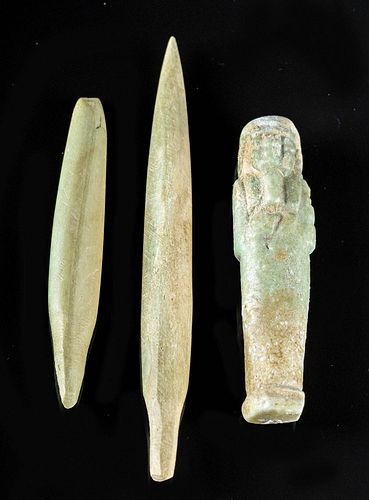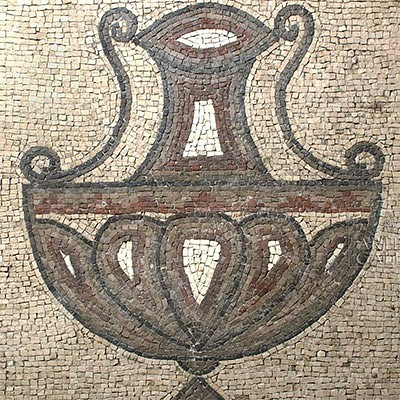Egyptian Faience Ushabti + 2 Carved Bone Hair Pins
Lot 8
About Seller
Artemis Gallery
686 S Taylor Ave, Ste 106
Louisville, CO 80027
United States
Selling antiquities, ancient and ethnographic art online since 1993, Artemis Gallery specializes in Classical Antiquities (Egyptian, Greek, Roman, Near Eastern), Asian, Pre-Columbian, African / Tribal / Oceanographic art. Our extensive inventory includes pottery, stone, metal, wood, glass and textil...Read more
Categories
Estimate:
$600 - $900
Absentee vs Live bid
Two ways to bid:
- Leave a max absentee bid and the platform will bid on your behalf up to your maximum bid during the live auction.
- Bid live during the auction and your bids will be submitted real-time to the auctioneer.
Bid Increments
| Price | Bid Increment |
|---|---|
| $0 | $25 |
| $300 | $50 |
| $1,000 | $100 |
| $2,000 | $250 |
| $5,000 | $500 |
| $10,000 | $1,000 |
| $20,000 | $2,500 |
| $50,000 | $5,000 |
| $100,000 | $10,000 |
| $200,000 | $20,000 |
About Auction
By Artemis Gallery
Sep 22, 2020
Set Reminder
2020-09-22 12:00:00
2020-09-22 12:00:00
America/New_York
Bidsquare
Bidsquare : Antiquities - Egypt, Greece, Italy, Near East
https://www.bidsquare.com/auctions/artemis-gallery/antiquities---egypt-greece-italy-near-east-5663
Featuring Egyptian, Greek, Roman, Etruscan & Near Eastern art. If you love the classics, this is the sale for you. All artifacts offered for sale have been legally acquired, are legal to sell and are guaranteed to be as described. In-house shipping for your convenience. Artemis Gallery info@artemisgallery.com
Featuring Egyptian, Greek, Roman, Etruscan & Near Eastern art. If you love the classics, this is the sale for you. All artifacts offered for sale have been legally acquired, are legal to sell and are guaranteed to be as described. In-house shipping for your convenience. Artemis Gallery info@artemisgallery.com
- Lot Description
Egypt, Late Dynastic Period, 26th to 31st Dynasty, ca. 664 to 332 BCE. Two beautifully hand carved Egyptian hair pins made of bovine bone and a delightful mold-formed faience ushabti, all decorated in hues of cream, buff, and sage green. With elongated forms and sharp ends, the two pins would have been used for securing long hair in an upswept style and are typically found in female tombs. The faience Ushabti stands in mummiform with fused legs and feet and also would have been found in a tomb, as ushabti were meant to be servants for the deceased. Intended to help with agricultural labor in the afterlife, the sculpture holds a pick and hoe in arms crossed atop the chest. Seen as indispensable in the afterlife for the recently deceased, these examples now enhance the aesthetic value of our present lives! Size of Largest: 3.6875" L x 0.25" W x 0.4375" H (9.4 cm x 0.6 cm x 1.1 cm)
Ushabti (or shabti) dolls are figures shaped like adult male or female mummies wearing traditional ancient Egyptian headdresses and were intended top help the recently deceased with agricultural labor in the afterlife. The ancient Egyptians believed that after they died, their spirits would have to work in the "Field of Reeds" owned by the god of the underworld, Osiris. This meant doing agricultural labor was required by all members of society, from workers to pharaohs.
Ancient hair pins were frequently used as weapons in history and literature according to many primary sources. For example: in "Roman History", Cassius Dio reports how Fulvia stabbed the tongue of Cicero's decapitated head with her hair pin and, in "The Golden Ass", Apuleius writes of a woman who stabs her husband's murderer in the eyes with her hairpins. Undoubtedly most notable, however, is Cleopatra's suicide, during which she is believed to have administered the asp's poison via cutting herself with her hairpin, "swiftly terminating three thousand years of pharaonic rule and changing the course of Western history." (Fletcher, J. 2016 The Egyptian Hair Pin: practical, sacred, fatal, Internet Archaeology 42.)
Provenance: ex Estate of Eldert Bontekoe, Pegasi Numismatics, Ann Arbor, Michigan USA acquired before 2000
All items legal to buy/sell under U.S. Statute covering cultural patrimony Code 2600, CHAPTER 14, and are guaranteed to be as described or your money back.
A Certificate of Authenticity will accompany all winning bids.
We ship worldwide and handle all shipping in-house for your convenience.
#158460Minor chips/nicks commensurate with age. Expected softening of detail and green marking on back on Ushabti. Lovely earthen deposits throughout. Overall, intact and excellent.Condition
- Shipping Info
-
All shipping is handled in-house for your convenience. Your invoice from Artemis Gallery will include shipping calculation instructions. If in doubt, please inquire BEFORE bidding for estimated shipping costs for individual items.
-
- Buyer's Premium



 EUR
EUR CAD
CAD AUD
AUD GBP
GBP MXN
MXN HKD
HKD CNY
CNY MYR
MYR SEK
SEK SGD
SGD CHF
CHF THB
THB













